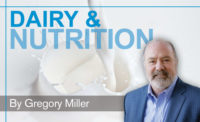The world’s population is projected to grow by one-third over the next 30 years, requiring a dramatic increase in food production with fewer natural resources. This goes beyond more food; it will involve producing nutritious foods that are diverse, culturally appropriate, affordable and accepted by consumers. The health of future generations is linked to the health of our planet, so sustainable food systems are core to the dairy community’s response.
Skeptics are quick to criticize dairy on environmental sustainability. Understanding consumers’ points of view helps us remain relevant. According to the 2019 International Food Information Council (IFIC) Food and Health Survey, 54% of consumers think food should be produced in an environmentally sustainable way.
We have an opportunity to better share that dairy provides lasting and meaningful nourishment to people, to the planet and to our communities. U.S. dairy farmers uphold a generations-long commitment to caring for their animals and land, and the industry has made — and will continue to make — progress in these areas.
One example is the Farmers Assuring Responsible Management (FARM) animal care program, which represents more than 98% of the domestic milk supply. FARM is the first livestock program in the world to be recognized by International Organization for Standardization Animal Welfare Management.
The dairy community should communicate that it is part of the solution to health and sustainable food systems. Gut health, technology investments, economic sustainability and environmental-impact reductions are some other considerations to propel dairy’s future.
Gut health
Our understanding of the importance of a diverse and resilient microbiome for overall well-being has led to increased interest in digestive health. Research indicates everything from metabolic to cognitive health is interwoven into the health of our microbiome. So where does dairy fit?
Understanding the complexity of the microbiome is a young science. However, milk is needed to make yogurt with live and active cultures, which is one of the most identified food sources of probiotics. Also, yogurt and natural cheese are fermented foods, which may be linked to digestive benefits and lower inflammation. National Dairy Council (NDC) has ongoing research on digestive health, metabolic health (including inflammation) and cognition — all of which are linked to the microbiome.
Technology investments
People use mobile apps, the internet and texts to order food. Ensuring dairy is part of these services is necessary to stay relevant. This includes research and development to create shelf-stable options or technology allowing safe temperature control.
There is broader potential in precision nutrition, which is partially driven by the research on the microbiome and increased public interest in the concept of “food as medicine” — 80% of consumers have adopted this approach to eating (https://tinyurl.com/vlqwq9t).
Economic sustainability
Economic sustainability often is overlooked, yet it offers opportunities for dairy. A recent NDC-funded modeling study illustrated the potential healthcare cost savings associated with increasing dairy consumption to the recommended three servings versus the current average of one and a half servings among U.S. adults.
If U.S. adults ate the recommended three servings, there would be an estimated $12.5 billion in annual cost savings. The savings were a result of risk reduction in type 2 diabetes, hypertension, stroke and colorectal cancer (factoring in a potential increased risk of Parkinson’s disease and prostate cancer).
Environmental-impact reductions
Technologies that help farmers further reduce their environmental impact are vital to the future of food. Producing a gallon of milk in 2017 involved 30% less water, 21% less land, a 19% smaller carbon footprint and 20% less manure than it did in 2007 — largely due to advances in technology. Solar panels, customized cow nutrition and upcycling manure are ways dairy farmers address environmental impact.
Ongoing progress in environmental stewardship, advancements in on-farm technologies and continued investment in science on dairy’s health benefits are fundamental to a successful future. Equally important to success is engaging with consumers.


